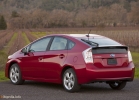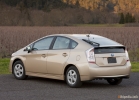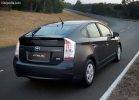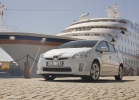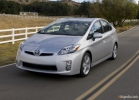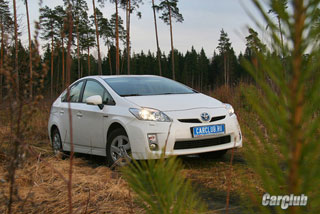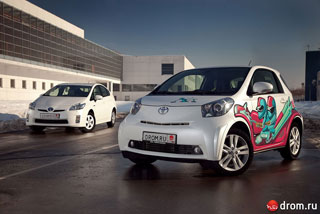Toyota Prius test drive since 2009 hatchback
Third -generation review of the Toyota Prius hybrid
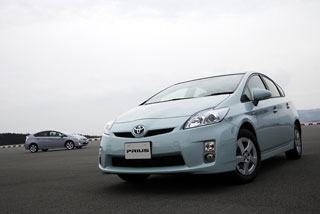 Among the cars that saw the light this year, the Toyota Prius of the third generation was undoubtedly the center of universal attention. What development did the model receive, 12 years after the debut of Prius? We learned about this during a test trip, on which we managed to get a car shortly before it appeared on the shelves of car dealers.
Among the cars that saw the light this year, the Toyota Prius of the third generation was undoubtedly the center of universal attention. What development did the model receive, 12 years after the debut of Prius? We learned about this during a test trip, on which we managed to get a car shortly before it appeared on the shelves of car dealers. Japanese auto industry icon 2009
It seems that 2009 can already be considered the year of a hybrid car. Only three weeks ago we took the new Honda Insight on the test drive, and now the fresh from Toyota, the prototype of the new generation Prius, the start of sales is scheduled for May. For one month, about 8,000 applications were submitted on Honda Insight. As it became known, the price of the new Prius will be at least 2,050,000 yen (about $ 21,800). Auto -journalists are actively exaggerating the topic of war between two hybrids. We will not enter into disputes about who is destined to become a winner in this struggle, although I have its opinion precisely Prius will become a symbol of the entire Japanese auto industry this year.
More comfort for rear passengers
The updated body, as it should be visible from the photos, is not at all large. Compared to the current generation, the length of the machine is increased by only 15 mm, and the width of 20 mm, the height of the body and the length of the wheelbase remained the same. Aerodynamics are thought out to the smallest detail, the frontal resistance coefficient of the hybrid is only 0.25.
Another difference from the current model: the highest point of the roof is shifted to the center of the cab (earlier it was right above the heads of the driver and the front passenger). Thanks to this, comfort in the placement of the rear passengers was added now, with a height of 170 cm, here you can not be afraid to hit your head. The backs of the front seats became thinner by 30 mm, which also added places for the knees. I was also pleased with the changed angle between the seat and the back of the rear sofa. In a word, the highest level of comfort in the class of 2-liter sedans.
I have not experienced any inconvenience associated with the thinner backs of the front seats in a short time. In the intricate lines of the dashboard, the motive of the sheet, dotted with veins, can be traced. In some ways, however, Prius lost its originality: the gearbox handle moved to the central console raised above the floor (it used to be located on the dashboard).
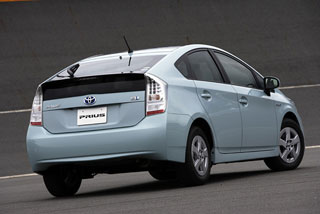 Soft move?
Soft move? What affected the renewal of the hybrid system: the engine volume with the Atkinson cycle increases from 1.5 to 1.8 liters; The electric motor is equipped with a planetary gearbox similar to that on the hybrid modifications of Toyota Estima and Toyota Harrier; As well as the system is supplemented by an electronic oil pump and a unique system of heat recovery for exhaust gases. In general, the configuration remained the same.
I click on the start button, I choose the position D, easily and smoothly press on the gas and on the road. At first I gain speed only by an electric motor, as before. The motor works unusually quietly. I shake the accelerator further, activating the gasoline engine, and I feel very solid speed potential. The engine is mounted very close to the dashboard, but everything is very quiet.
I also noted a couple of unpleasant moments: firstly, at times there are jerks in motion, and secondly, there is a shaking of the body. Of course, this can be partially explained by the lightness of aluminum structures, however, a shortage is clearly felt here. Depending on the configuration, the car is equipped with 15- or 17-inch wheels. The latter, of course, are more quiet. On a mini-track, I was impressed by the effective work of the brakes and the hardness of the body: imagine, you are breaking away, and the car forgives this error, leaving the opportunity to return to direct trajectory. Security!
A striking little one
In addition to the EV Mode mode (movement exclusively on electric traction), the new model received two more: Eco Mode (economical mode) and Power Mode (for dynamic driving), however, what is their significant difference from ordinary, I did not particularly understand. The ECO Drive display displays information about the mode used in the form of a monochrome histogram. The information content of the image does not cause doubts, but it looks poor if you recall the three-color display on Honda Insight.
But I must admit that all the troubles are forgotten when you find out how much gasoline this car needs for life. With a conventional driving style, with stops and lifts, the fuel flow sensor on the car shows 1 liter per 25 km (4 liters per 100 km). By choosing an eco-mode, you can reach an incredible level of 1 liter per 57 km (1.75 liters per 100 km)!
 More than a decade after the appearance of the first hybrid, the cost of the hybrid system continues to fall, the chassis is no longer so hard, and, in general, everything is fine. The base model of Prius as additional equipment is equipped with the Solar Ventilation system (ventilation of the salon from the energy of solar batteries located on the roof), so there is nothing surprising in the declared price of 2,050,000 yen.
More than a decade after the appearance of the first hybrid, the cost of the hybrid system continues to fall, the chassis is no longer so hard, and, in general, everything is fine. The base model of Prius as additional equipment is equipped with the Solar Ventilation system (ventilation of the salon from the energy of solar batteries located on the roof), so there is nothing surprising in the declared price of 2,050,000 yen. However, there is a fear: as if price competition in the struggle for the consumer did not turn a car into a semblance of faceless plasma panels, which are shaft, and try to distinguish.
Technical characteristics of the prototype Toyota Prius
Full length: 4 460 mm.
Full width: 1 745 mm.
Complete height: 1,490 mm.
Wheel base: 2 700 mm.
Drive: front.
Engine: 1.8-liter 4-cylinder DOHC with 16 valves; The maximum system of the system is 136 hp
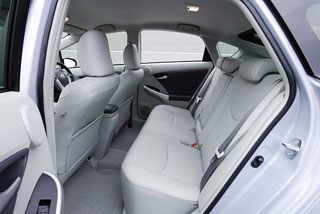
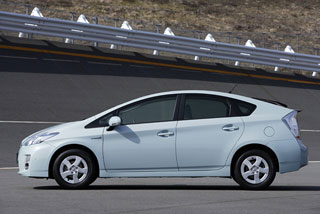


A source: webcg.net

